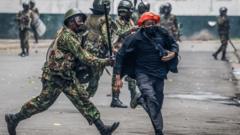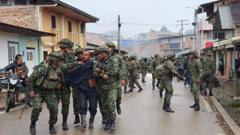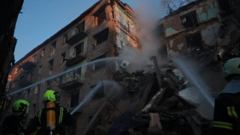As protests erupt across Kenya, a leading human rights organization confirms the death toll has reached 16, with thousands demonstrating against government corruption and police brutality.
Rising Death Toll from Nationwide Protests in Kenya: Human Rights Group Reports

Rising Death Toll from Nationwide Protests in Kenya: Human Rights Group Reports
Protests against government corruption and police brutality escalate, leaving 16 dead and hundreds injured across Kenya.
Stones and debris still cover the streets of Kenya’s capital city, Nairobi, on Thursday following a day of intense protests that have drawn thousands of citizens demanding accountability from their government. The protests, which took place on Wednesday, have resulted in a reported death toll of 16 according to a prominent human rights group, largely attributed to police violence.
Demonstrators rallied against the government’s persistent issues of corruption and police brutality, calling for President William Ruto to resign. Eyewitness accounts describe clashes between protesters and security forces as officers resorted to firing both live rounds and rubber bullets, coupled with deploying tear gas.
Irũngũ Houghton, head of Amnesty Kenya, disclosed that the number of fatalities rose as reports surfaced from hospitals and other credible sources overnight, with many victims suffering from gunshot wounds. One such victim was identified as Fred Wamale Wanyonyi, a security guard who tragically lost his life near the headquarters of Kenya Power.
Authorities claim over 400 injuries resulted from the protests, with more than 80 individuals sustaining serious injuries. In the aftermath, reports indicated that at least 61 participants had been arrested as protests swept through various counties, suggesting widespread grievances against the current administration.
In response to the protests, local media reported outbreaks of violence, including police stations being set on fire and looting occurring in several locations, although the full damage remains yet to be quantified. As scenes of destruction unfold downtown Nairobi, businesses just beginning to reopen under a heavy police presence face an atmosphere filled with tension and uncertainty.
In advance of the protests gaining traction, the Kenyan government imposed a media blackout that hindered all live coverage by television and radio stations, a decision that faced backlash from media organizations and human rights advocates. Notably, access to the messaging app Telegram was restricted, prompting a legal challenge against such censorship, which led to a temporary suspension of the blackout.
These demonstrations didn’t occur in a vacuum; they mark the anniversary of last year’s protests, notorious for resulting in over 60 deaths. The aftermath witnessed many protesters forcibly abducted and tortured—a grim reality that continues to haunt the nation.
Despite government assurances of accountability, tensions simmer as citizens express ongoing frustrations connected to the economic landscape and the repressive tactics employed by law enforcement. The events unfolding today represent a deeper frustration with systemic issues that these protests amplifying across the nation.




















